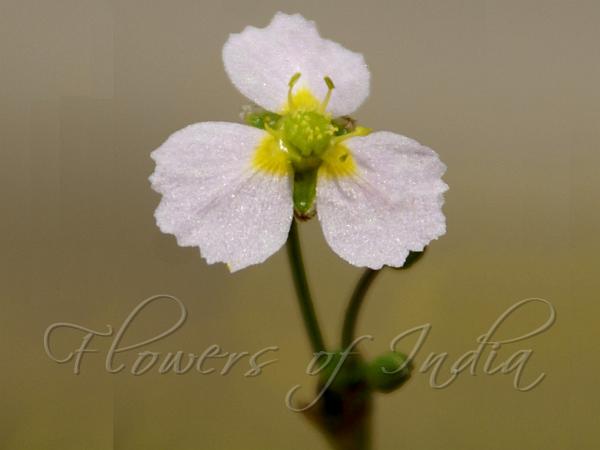|
| Common Water Plantain |
|

|

| File size | 163930 |
| Original date | 7/25/11 10:52 AM |
| Resolution | 1520 x 1140 |
| Flash | Flash did not fire, auto |
| Focal length | 50.0mm |
| Exposure time | 1/1250s |
| Aperture | 5.6 |
| Focus Distance | |
| Metering Mode | Multi-segment |
| Camera make | SONY |
| Camera model | DSLR-A100 |
| Sensor type |
|
|
|
|
Photo: |
Botanical name: Alisma plantago-aquatica Family: Alismataceae (Water Plantain family)
Common Water-plantain is a perennial flowering
plant native to most of the Northern Hemisphere, in Europe, northern
Asia, and North America. It is found on mud or in fresh waters. It is a
hairless plant that grows in shallow water, consists of a fibrous root,
several basal long stemmed leaves 15-30 cm long, and a triangular stem
up to 1 m tall. Leaves are ovate-lanceshaped or ovate, rounded or
heart-shaped at base. It has branched inflorescence bearing numerous
small flowers, 1 cm across, with three round or slightly jagged, white
or pale purple, petals. The flowers open in the afternoon. Flowers have
3 blunt green sepals, and 6 stamens. The carpels often exist as a flat
single whorl. Flowering: June-August.
Medicinal uses:  It is a Chinese medicinal herb used for edema, diarrhea, strangury,
vaginal discharge, dizziness, painful urination, seminal emission,
nightsweating, lumbar pain. The dried leaves of the water plantain can
be used as both a diuretic and a diaphoretic. They have been used to
help treat renal calculus, cystitis, dysentery and epilepsy. The roots
have formerly been used to cure hydrophobia, and have a reputation in
America of curing rattlesnake bites. However this is not proven.
It is a Chinese medicinal herb used for edema, diarrhea, strangury,
vaginal discharge, dizziness, painful urination, seminal emission,
nightsweating, lumbar pain. The dried leaves of the water plantain can
be used as both a diuretic and a diaphoretic. They have been used to
help treat renal calculus, cystitis, dysentery and epilepsy. The roots
have formerly been used to cure hydrophobia, and have a reputation in
America of curing rattlesnake bites. However this is not proven.
 It is a Chinese medicinal herb used for edema, diarrhea, strangury,
vaginal discharge, dizziness, painful urination, seminal emission,
nightsweating, lumbar pain. The dried leaves of the water plantain can
be used as both a diuretic and a diaphoretic. They have been used to
help treat renal calculus, cystitis, dysentery and epilepsy. The roots
have formerly been used to cure hydrophobia, and have a reputation in
America of curing rattlesnake bites. However this is not proven.
It is a Chinese medicinal herb used for edema, diarrhea, strangury,
vaginal discharge, dizziness, painful urination, seminal emission,
nightsweating, lumbar pain. The dried leaves of the water plantain can
be used as both a diuretic and a diaphoretic. They have been used to
help treat renal calculus, cystitis, dysentery and epilepsy. The roots
have formerly been used to cure hydrophobia, and have a reputation in
America of curing rattlesnake bites. However this is not proven. | Identification credit: Gurcharan Singh | Photographed in Gulmarg, Kashmir. |
• Is this flower misidentified? If yes,